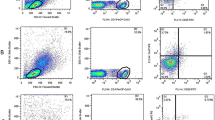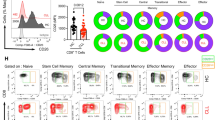Abstract
To study the distribution profile of CD45RO+ and CD45RA+ T cells in the peripheral blood of peripheral T cell lymphoma (PTCL) patients and its clinical significance. 27 patients with PTCL were enrolled in this study, together with 30 healthy individuals as the control group. Flow cytometry analysis was employed to examinate the differences in the distribution of CD45RO+ and CD45RA+ T cells in peripheral blood between two groups. In PTCL patient’s lymphnode tissues, the T cell population displayed diverse antigenic expression, with CD4+ T cells as the major subset. No B cell-related antigen was expressed. The percentage of CD4+/CD8+ and CD4+CD45RO+ T cells in patients’ peripheral blood were significantly lower than that in the control samples, while the percentage of CD4+CD45RA+, CD8+CD45RA+, and CD8+CD45RO+ T cells in patients’ peripheral blood were significantly higher than that in the control samples. The percentage of CD4+/CD8+, CD4+CD45RO+ cells in stage I/II PTCL patients’ peripheral blood were significantly higher than that in the samples from patients with stage III/IV PTCL. The percentage of CD4+CD45RA+, CD8+CD45RA+, and CD8+CD45RO+ T cells were notably lower than that in the samples from III/IV period PTCL patients. Both CD45RO+ and CD45RA+ T cells play important roles in the process of PTCL. The immunophenotypic profile from this study will help to develop the differential diagnosis and treatment of PTCL patients in the future, and improve the accuracy rate of diagnosis and to ameliorate the prognosis.

Similar content being viewed by others
References
Takata, Y., Nakamoto, Y., Nakada, A., Terashima, T., Arihara, F., Kitahara, M., et al. (2011). Frequency of CD45RO+ subset in CD4+CD25(high) regulatory T cells associated with progression of hepatocellular carcinoma. Cancer Letters, 307(2), 165–173.
de Chaisemartin, L., Goc, J., Damotte, D., Validire, P., Magdeleinat, P., Alifano, M., et al. (2011). Characterization of chemokines and adhesion molecules associated with T cell presence in tertiary lymphoid structures in human lung cancer. Cancer Research, 71(20), 6391–6399.
Czystowska, M., Gooding, W., Szczepanski, M. J., Lopez-Abaitero, A., Ferris, R. L., Johnson, J. T., et al. (2013). The immune signature of CD8(+)CCR7(+) T cells in the peripheral circulation associates with disease recurrence in patients with HNSCC. Clinical Cancer Research, 19(4), 889–899.
Sakaguchi, S., Miyara, M., Costantino, C. M., & Hafler, D. A. (2010). FOXP3+ regulatory T cells in the human immune system. Nature Reviews Immunology, 10(7), 490–500.
Nehme, N. T., Pachlopnik Schmid, J., Debeurme, F., Andre-Schmutz, I., Lim, A., Nitschke, P., et al. (2012). MST1 mutations in autosomal recessive primary immunodeficiency characterized by defective naive T-cell survival. Blood, 119(15), 3458–3468.
Quintarelli, C., Dotti, G., Hasan, S. T., De Angelis, B., Hoyos, V., Errichiello, S., et al. (2011). High-avidity cytotoxic T lymphocytes specific for a new PRAME-derived peptide can target leukemic and leukemic-precursor cells. Blood, 117(12), 3353–3362.
Perna, S. K., De Angelis, B., Pagliara, D., Hasan, S. T., Zhang, L., Mahendravada, A., et al. (2013). Interleukin 15 provides relief to CTLs from regulatory T cell-mediated inhibition: Implications for adoptive T cell-based therapies for lymphoma. Clinical Cancer Research, 19(1), 106–117.
Izawa, S., Mimura, K., Watanabe, M., Maruyama, T., Kawaguchi, Y., Fujii, H., et al. (2013). Increased prevalence of tumor-infiltrating regulatory T cells is closely related to their lower sensitivity to H2O2-induced apoptosis in gastric and esophageal cancer. Cancer Immunology Immunotherapy, 62(1), 161–170.
Warren, R. L., Freeman, J. D., Zeng, T., Choe, G., Munro, S., Moore, R., et al. (2011). Exhaustive T-cell repertoire sequencing of human peripheral blood samples reveals signatures of antigen selection and a directly measured repertoire size of at least 1 million clonotypes. Genome Research, 21(5), 790–797.
Mlecnik, B., Tosolini, M., Charoentong, P., Kirilovsky, A., Bindea, G., Berger, A., et al. (2010). Biomolecular network reconstruction identifies T-cell homing factors associated with survival in colorectal cancer. Gastroenterology, 138(4), 1429–1440.
Liepert, A., Grabrucker, C., Kremser, A., Dreyssig, J., Ansprenger, C., Freudenreich, M., et al. (2010). Quality of T-cells after stimulation with leukemia-derived dendritic cells (DC) from patients with acute myeloid leukemia (AML) or myeloid dysplastic syndrome (MDS) is predictive for their leukemia cytotoxic potential. Cellular Immunology, 265(1), 23–30.
Bae, J., Carrasco, R., Lee, A. H., Prabhala, R., Tai, Y. T., Anderson, K. C., et al. (2011). Identification of novel myeloma-specific XBP1 peptides able to generate cytotoxic T lymphocytes: A potential therapeutic application in multiple myeloma. Leukemia, 25(10), 1610–1619.
Tabi, Z., Spary, L. K., Coleman, S., Clayton, A., Mason, M. D., & Staffurth, J. (2010). Resistance of CD45RA-T cells o apoptosis and functional impairment, and activation of tumor-antigen specific T cells during radiation therapy of prostate cancer. Journal of Immunology, 185(2), 1330–1339.
Conrad, C., Gregorio, J., Wang, Y. H., Ito, T., Meller, S., Hanabuchi, S., et al. (2012). Plasmacytoid dendritic cells promote immunosuppression in ovarian cancer via ICOS costimulation of Foxp3(+) T-regulatory cells. Cancer Research, 72(20), 5240–5249.
Fourcade, J., Sun, Z., Benallaoua, M., Guillaume, P., Luescher, I. F., Sander, C., et al. (2010). Upregulation of Tim-3 and PD-1 expression is associated with tumor antigen-specific CD8+ T cell dysfunction in melanoma patients. The Journal of Experimental Medicine, 207(10), 2175–2186.
Noguchi, A., Kaneko, T., Naitoh, K., Saito, M., Iwai, K., Maekawa, R., et al. (2014). Impaired and imbalanced cellular immunological status assessed in advanced cancer patients and restoration of the T cell immune status by adoptive T-cell immunotherapy. International Immunopharmacology, 18(1), 90–97.
Cutler, C., Stevenson, K., Kim, H. T., Brown, J., McDonough, S., Herrera, M., et al. (2011). Double umbilical cord blood transplantation with reduced intensity conditioning and sirolimus-based GVHD prophylaxis. Bone Marrow Transplantation, 46(5), 659–667.
Martinez-Navio, J. M., Casanova, V., Pacheco, R., Naval-Macabuhay, I., Climent, N., Garcia, F., et al. (2011). Adenosine deaminase potentiates the generation of effector, memory, and regulatory CD4+ T cells. Journal of Leukocyte Biology, 89(1), 127–136.
Camisaschi, C., Casati, C., Rini, F., Perego, M., De Filippo, A., Triebel, F., et al. (2010). LAG-3 expression defines a subset of CD4(+)CD25(high)Foxp3(+) regulatory T cells that are expanded at tumor sites. Journal of Immunology, 184(11), 6545–6551.
Fadul, C. E., Fisher, J. L., Gui, J., Hampton, T. H., Cote, A. L., & Ernstoff, M. S. (2011). Immune modulation effects of concomitant temozolomide and radiation therapy on peripheral blood mononuclear cells in patients with glioblastoma multiforme. Neuro-oncology, 13(4), 393–400.
Schuler, P. J., Schilling, B., Harasymczuk, M., Hoffmann, T. K., Johnson, J., Lang, S., et al. (2012). Phenotypic and functional characteristics of CD4+CD39+FOXP3+ and CD4+CD39+FOXP3neg T-cell subsets in cancer patients. European Journal of Immunology, 42(7), 1876–1885.
Gattinoni, L., Lugli, E., Ji, Y., Pos, Z., Paulos, C. M., Quigley, M. F., et al. (2011). A human memory T cell subset with stem cell-like properties. Nature Medicine, 17(10), 1290–1297.
Hardie, D. L., Baldwin, M. J., Naylor, A., Haworth, O. J., Hou, T. Z., Lax, S., et al. (2011). The stromal cell antigen CD248 (endosialin) is expressed on naive CD8+ human T cells and regulates proliferation. Immunology, 133(3), 288–295.
Fridman, W. H., Galon, J., Pages, F., Tartour, E., Sautes-Fridman, C., & Kroemer, G. (2011). Prognostic and predictive impact of intra- and peritumoral immune infiltrates. Cancer Research, 71(17), 5601–5605.
Lee, Y. S., Kim, T. S., & Kim, D. K. (2011). T lymphocytes derived from human cord blood provide effective antitumor immunotherapy against a human tumor. BMC Cancer, 11, 225.
Voo, K. S., Bover, L., Harline, M. L., Vien, L. T., Facchinetti, V., Arima, K., et al. (2013). Antibodies targeting human OX40 expand effector T cells and block inducible and natural regulatory T cell function. Journal of Immunology, 191(7), 3641–3650.
Jedema, I., van de Meent, M., Pots, J., Kester, M. G., van der Beek, M. T., & Falkenburg, J. H. (2011). Successful generation of primary virus-specific and anti-tumor T-cell responses from the naive donor T-cell repertoire is determined by the balance between antigen-specific precursor T cells and regulatory T cells. Haematologica, 96(8), 1204–1212.
Pourgheysari, B., Bruton, R., Parry, H., Billingham, L., Fegan, C., Murray, J., et al. (2010). The number of cytomegalovirus-specific CD4+ T cells is markedly expanded in patients with B-cell chronic lymphocytic leukemia and determines the total CD4+ T-cell repertoire. Blood, 116(16), 2968–2974.
Hinrichs, C. S., Borman, Z. A., Gattinoni, L., Yu, Z., Burns, W. R., Huang, J., et al. (2011). Human effector CD8+ T cells derived from naive rather than memory subsets possess superior traits for adoptive immunotherapy. Blood, 117(3), 808–814.
Lysaght, J., Allott, E. H., Donohoe, C. L., Howard, J. M., Pidgeon, G. P., & Reynolds, J. V. (2011). T lymphocyte activation in visceral adipose tissue of patients with oesophageal adenocarcinoma. The British Journal of Surgery, 98(7), 964–974.
Conflict of interest
The authors have no conflicts of interest to declare.
Author information
Authors and Affiliations
Corresponding author
Additional information
Wenzhong Yang and Xinyan Jia have contributed equally to this work.
Rights and permissions
About this article
Cite this article
Yang, W., Jia, X., Su, Y. et al. Immunophenotypic Characterization of CD45RO+ and CD45RA+ T Cell Subsets in Peripheral Blood of Peripheral T Cell Lymphoma Patients. Cell Biochem Biophys 70, 993–997 (2014). https://doi.org/10.1007/s12013-014-0008-3
Published:
Issue Date:
DOI: https://doi.org/10.1007/s12013-014-0008-3




